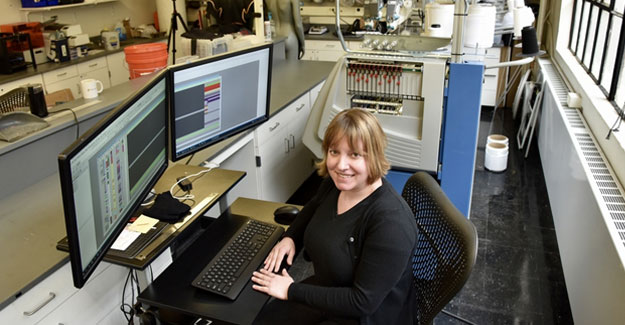
Fabric + Form = A Mask That Uniquely Fits Your Face
Department of Architecture doctoral candidate Lavender Tessmer has advanced the process to produce textiles that can be individually customised. Lavender Tessmer, a doctoral candidate in MIT’s Department of Architecture, has developed a new active fibre and designed a process that — combined with a specific knit textile architecture — uses heat to activate a mask to conform to an individual’s face. With standard textile equipment and the new customisation process, any manufacturer can create a customised mask. A head start A few years before the pandemic, Tibbits’s lab received a grant from Advanced Functional Fibers of America (AFFOA) to develop “smarter textiles” that would be able to sense, respond, and transform. The research led to a partnership with Ministry of Supply — a fashion company specialising in high-tech apparel — to develop a new system for “smart textiles.” Created by MIT graduates, Ministry of Supply uses temperature-regulating material to design and produce environmentally sustainable clothing geared to professionals. In spring 2020, a confluence of events shifted their collaboration. The global pandemic forced businesses to close in March; the Department of Architecture called for proposals to fund research positions for students to work with faculty on “crisis-related research,” including design responses to the pandemic; and the need for masks to protect first responders and the general public became apparent. Tibbits’s research received department funding. “Lavender was already trying to make textile apparel with a customised fit, so we could quickly transition to making customised masks,” says Tibbits. “But the main challenge with any customisation is that you cannot make each mask unique. It becomes a factory logistics problem. You have to be able to mass-produce these. Customers don’t want to wait weeks or months for their unique mask.” How, then, is a mass-produced mask tailored for an individual face? “Lavender created the knit structure — the architecture — of the mask,” says Tibbits. “The material properties alone don’t lead to the behaviour of precise transformation. It’s basically two- or three-dimensionally knitting structures, and with every single stitch you can change the structure and the materials.” Tessmer also developed one of the two active fibres (the other was already commercially available) needed to respond to heat so the fabric could be controlled in a predictable way. “There had to be a clear relationship between how much heat is applied, the method of applying it with the robot, and having a predictable result in the dimensional transformation of the fabric,” says Tessmer. “That was an iterative process between developing the multi-layered fabric, measuring its dimensional change, and then eventually being able to have the robot apply heat in a repeatable and predicable way.” Already in the public realm were guidelines for existing ranges of human facial feature measurements. The starting shape of the mask is large enough for almost every face before it’s transformed and customised. From there, Tessmer input dimensions from an individual’s face and the knit masks were activated with a robotic arm outfitted with a heat gun that applies heat in specific patterns to tailor them precisely to the facial measurements. Covid-driven need for masks With their retail operations closed early in the pandemic, Ministry of Supply pivoted from making clothes to making face masks. “The strength of Lavender and Skylar’s work is that it takes advantage of additive manufacturing techniques, which can be spun up for production very quickly,” says Gihan Amarasiriwardena ’11, a Ministry of Supply co-founder and the company’s president. “Working with the Self-Assembly Lab, we were able to design, test, and develop a mask in five days and have 4,000 masks produced in two weeks for health care workers due to our ability to use 3D computerised knitting. I think this will be a critical asset in being able to divert existing materials toward masks very quickly in the future.” “The objective was to transform a mask to achieve the perfect fit for anyone’s face, which is a major challenge with masks and other pieces of clothing,” says Tibbits. “No one has really figured out how to do that, other than hiring a tailor or having lots of standard sizes that don’t fit perfectly.” It is important to note that Tessmer and Tibbits’s work was focused on a mask’s fit, and not the properties required for a mask’s material to filter out airborne particles — although a standard filter could be included to enhance its efficacy. The masks are also reusable and washable. “Our goal was better fibres and a controllable, repeatable process to create a custom-fit mask,” says Tessmer. “We created masks for nine different people to demonstrate how effective the process is.” Last fall a paper they co-authored, “Personalized Knit Masks: Programmable Shape Change for Customized Fit,” provided instructions to create “truly customisable masks” that conform to the unique facial features of any individual. The Association for Computer Aided Design in Architecture (ACADIA) honored Tessmer and Tibbits with its Best Paper Award for this groundbreaking work. “The award highlights the paper as exemplary, showcasing innovative research with substantial contribution to the described field,” noted the judges in their remarks. “Beyond demonstrating rigorous methods of research and disciplinary expertise, the paper is also well-written, bringing new insights to the ACADIA community and beyond.” (MIT News)
Textile Excellence
If you wish to Subscribe to Textile Excellence Print Edition, kindly fill in the below form and we shall get back to you with details.








